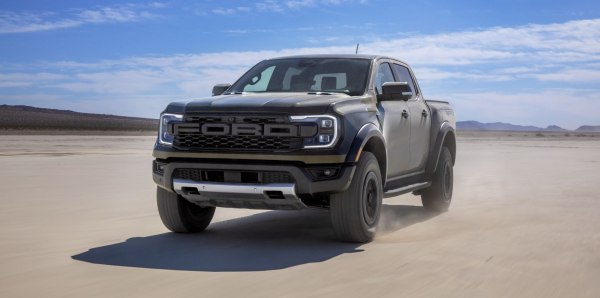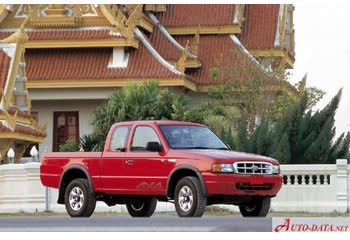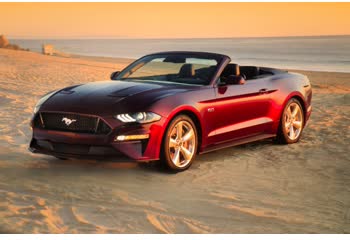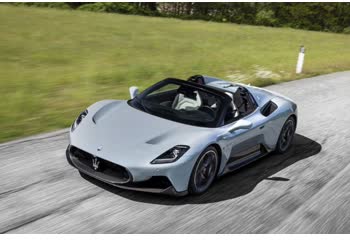Everything you need to know about specifications and performance - Ford Ranger 2023 - Raptor 3.0 EcoBoost V6 (405 Hp) 4x4 Automatic

Overview:
What is the engine capacity of a Ford Ranger 2023?
The engine capacity of the Ford Ranger 2023 is 2949 cm.
Ford Ranger 2023 How many horsepower?
The engine power of the Ford Ranger 2023 is 405 Hp.
What is the Ford Ranger 2023 engine?
Ford Ranger 2023 engine is EcoBoost. (Click to see other cars using the same engine)
General:
Brand: Ford
Model: Ranger
Generation: Ranger V SuperCrew (Americas)
Modification (Engine): Raptor 3.0 EcoBoost V6 (405 Hp) 4x4 Automatic
Start of production: 2023
End of production:
Powertrain Architecture: Internal Combustion Engine
Body type: Pickup
Seats: 5
Doors: 4
Engine:
Engine systems: Start & Stop System
Power: 405 hp
Power per litre: 137.3 hp/l
Torque: 583 nm
Engine Model/Code: EcoBoost
Engine displacement: 2949 cm
Number of cylinders: 6
Engine configuration: V-engine
Number of valves per cylinder: 4
Fuel injection system: Direct injection and Multi-port manifold injection
Engine aspiration: Twin-Turbo, Intercooler
Valvetrain: DOHC, TI-VCT
Engine layout: Front, Longitudinal
Cylinder Bore: 85.4 mm
Piston Stroke: 86 mm
Compression ratio: 10.5
Performance:
Fuel Type: Petrol (Gasoline)
Weight-to-power ratio: 6 kg/Hp, 167.7 Hp/tonne
Weight-to-torque ratio: 4.1 kg/Nm, 241.4 Nm/tonne
Space:
Kerb Weight: 2415 kg
Max. weight: 3080 kg
Max load: 665 kg
Trunk (boot) space - minimum: 1232 l
Permitted trailer load with brakes (12%): 2499 kg
Fuel tank capacity: 77 l
dimensions:
Ramp-over (brakeover) angle: 24.2°
Length: 5357 mm
Width: 2007 mm
Height: 1928 mm
wheelbase: 3269 mm
Width with mirrors folded: 2027 mm
Width including mirrors: 2202 mm
Front track: 1709 mm
Rear (Back) track: 1709 mm
Front overhang: 861 mm
Rear overhang: 1224 mm
Ride height (ground clearance): 272 mm
Minimum turning circle (turning diameter): 13.2 m
Approach angle: 33°
Departure angle: 26.4°
Powertrain, Suspension and Brakes:
Drivetrain Architecture: The Internal combustion Engine (ICE) drives the rear wheels permanently, and the front wheels are driven through an electrically or mechanically operated clutch if necessary.
Drive wheel: All wheel drive (4x4)
Number of gears and type of gearbox: 10 gears, automatic transmission
Front brakes: Ventilated discs, 310.9x33.78 mm
Rear brakes: Ventilated discs, 307.85x23.88 mm
Assisting systems: ABS (Anti-lock braking system)
Steering type: Steering rack and pinion
Power steering: Electric Steering
Tires size: 285/70 R17
Wheel rims size: 17
Front suspension: Double wishbone
Rear suspension: Rigid axle suspension, Coil Spring
See also

Other generation.
Its production began in 1998 until 2006

Same engine. (EcoBoost).
Its production began in 2019 until 2022

Same engine. (EcoBoost).
Its production began in 2009 until 2012

Same engine. (EcoBoost).
Its production began in 2017 until 2023

Same production year and almost the same engine capacity.
Its production began in 2023 until Now

Same production year and almost the same engine capacity.
Its production began in 2023 until Now
Write a comment